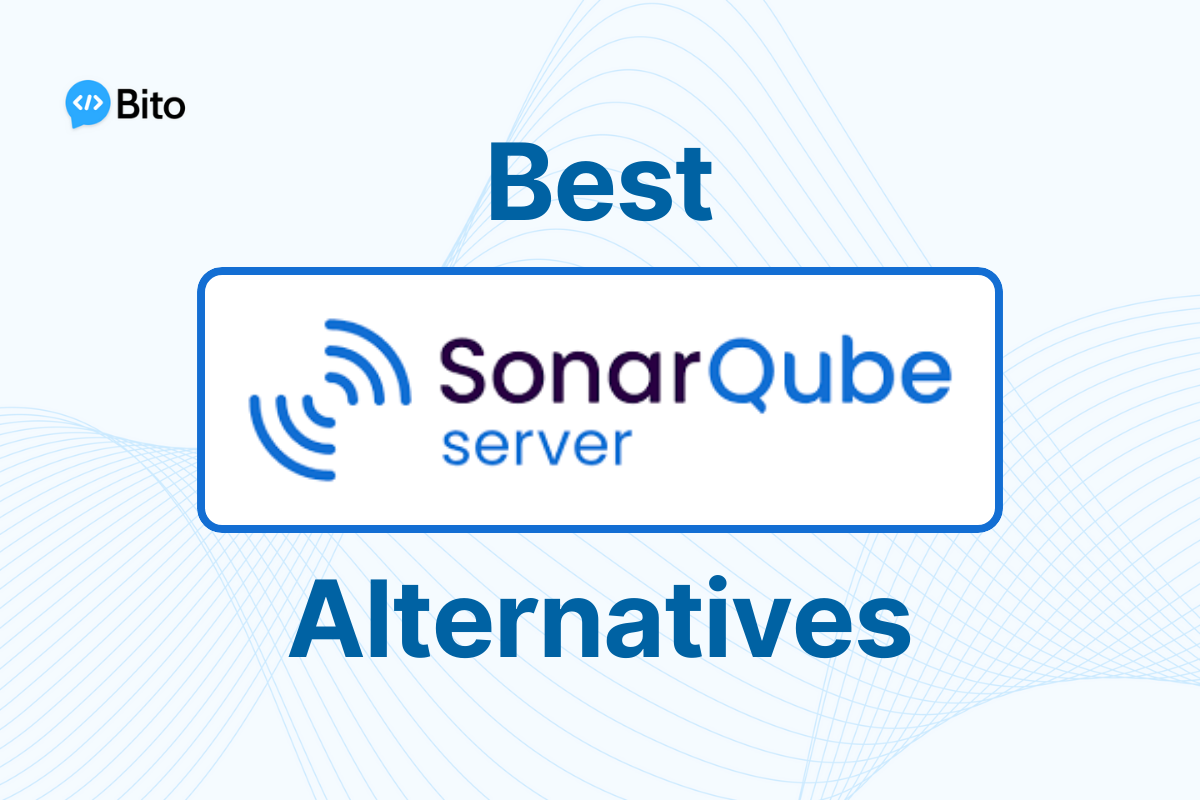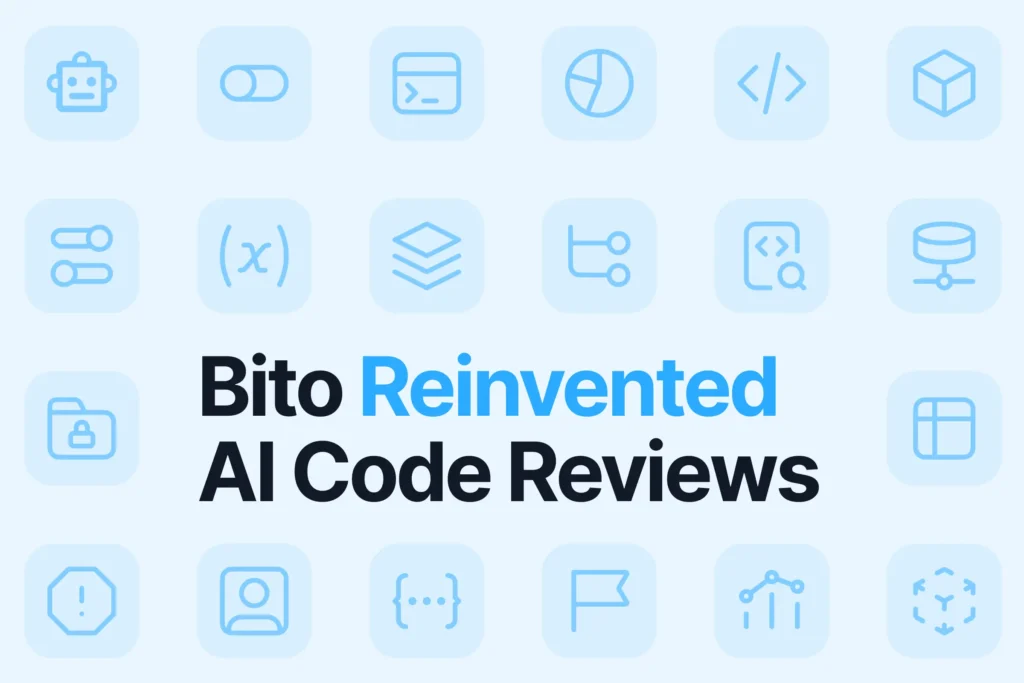Looking for the best SonarQube alternatives? Whether you’re seeking a free, open-source, or AI-powered option, this guide has you covered. We’ll explore top alternatives to SonarQube to help you choose the right code quality and security tool for your development workflow.
SonarQube has been a trusted tool for developers, helping teams ensure their code is clean, secure, and maintainable. By performing static code analysis, SonarQube identifies issues such as bugs, code smells, and vulnerabilities, providing valuable insights to improve code quality before deployment. It also supports enforcing coding standards and tracking technical debt, making it a go-to choice for many software teams.
However, as teams grow or adopt more complex workflows, some may find they need tools that go beyond what SonarQube offers.
For example, SonarQube focuses heavily on identifying issues but doesn’t provide personalized, actionable guidance for resolving them. It also lacks the ability to provide instant feedback during the coding process, which can slow down development. These gaps open the door for modern AI-powered solutions, like Bito’s AI Code Review Agent, which bring advanced capabilities to the table.
Bito’s AI Code Review Agent is a free SonarQube alternative that delivers objective, scalable, and instant code reviews directly within your workflow. It provides unbiased code review feedback and eliminates delays caused by waiting for senior engineers.
While Bito stands out as the best SonarQube alternative, we’ve also explored other tools that might suit different needs. This guide provides a comprehensive list of SonarQube competitors to help you choose the best fit for your development process.
Why look for a SonarQube alternative?
- Cost: SonarQube’s commercial editions can be expensive for startups or small teams.
- Setup complexity: Hosting and maintaining a SonarQube server requires resources.
- Feature gaps: Some users need better AI assistance or cloud-native features.
- Language support: Developers may need specialized tools for specific languages.
Key features to consider in SonarQube similar tools
- Support for the programming languages you use
- Easy integration with CI/CD tools
- Security and secret scanning capabilities
- Customizable quality rules and reporting
- AI assistance or automation features
- Open-source vs. managed cloud options
Top SonarQube alternatives (free, open source, and AI-powered)
1. Bito’s AI Code Review Agent
Bito’s AI Code Review Agent offers a unique approach to automated code reviews by leveraging AI to understand your entire codebase context.
Unlike traditional static analysis tools, Bito provides actionable suggestions and insights tailored to your specific coding environment, reducing the time spent on manual code reviews. Its deep integration with popular IDEs and Git workflows makes it an essential tool for developers who want precise feedback during development and after pull requests.
Many leading software development teams use Bito as a SonarQube replacement.
Key features
- Context-aware code review: Deep understanding of your code including libraries, frameworks, functionality to provide accurate suggestions.
- PR summary: Quick, comprehensive overviews of pull requests.
- Automated change list: Categorizes and lists changes in a pull request, making it easy to track key updates.
- AI code review: Assesses security, performance, scalability, optimization, impact on existing features, code structure, and coding standards.
- Tailored code suggestions: Precise, line-specific improvement suggestions.
- Static Code Analysis: In-depth analysis with tools like fbinfer and Sonar.
- Security vulnerability check: Uses tools like OWASP Dependency-Check for detecting severe security flaws.
- Supports Git workflows: Works within GitHub, GitLab, and Bitbucket to assist with real-time PR reviews.
- IDE integration: Seamlessly integrated with VSCode and JetBrains for in-editor code reviews.
- Instant feedback in IDE: Provides immediate reviews while you code, reducing the need for back-and-forth in pull requests.
- Supports multiple languages: Works across Python, JavaScript, Go, and more.
Pricing details
Bito offers a 14-day free trial for its 10X Developer Plan, priced at $15 per month, which includes unlimited AI code reviews and advanced features.
SonarQube vs Bito
SonarQube focuses on static code analysis, highlighting bugs, code smells, and vulnerabilities. It works best in structured CI/CD pipelines and supports multiple languages. However, it lacks real-time feedback and AI-powered insights.
Bito’s AI Code Review Agent analyzes pull requests using LLMs, linters, secret scanners, and vulnerability tools. It gives fast, contextual suggestions inside GitHub. Unlike SonarQube, Bito requires no complex setup and responds in seconds during code reviews.
Use Bito (SonarQube SAST alternative) if you want fast, AI-assisted code reviews and actionable suggestions without managing infrastructure.
2. Codacy
Codacy simplifies static code analysis and integrates seamlessly into your CI/CD pipeline. It supports over 40 programming languages and provides detailed reports on code quality, security vulnerabilities, and compliance issues. Codacy is especially popular for its clean interface and ability to integrate with Git-based workflows like GitHub, GitLab, and Bitbucket.
Its customizable rules engine allows teams to focus on specific coding standards, making it an excellent choice for large organizations with diverse codebases. Codacy also tracks key metrics, helping developers improve over time and ensuring compliance with industry standards.
Key features
- Automated code reviews: Reviews code for quality, style, and security issues across multiple languages.
- Language support: Covers 40+ programming languages, including Python, JavaScript, and Java.
- Customizable coding standards: Allows teams to define and enforce their own rules.
- Seamless CI/CD integration: Works with tools like Jenkins, Travis CI, and CircleCI for automated analysis.
- Code quality metrics: Tracks maintainability, complexity, and other key metrics for continuous improvement.
Pricing details
Codacy has a free plan with basic features. Paid plans start at $18 per user/month, offering advanced capabilities like compliance reporting and custom integrations.
SonarQube vs Codacy
SonarQube offers a rich feature set for deep code analysis and technical debt tracking, but it requires more setup and maintenance.
Codacy provides an easier cloud-based setup with similar static analysis features. It integrates with Git providers and offers pull request feedback. However, it lacks advanced customization and doesn’t support AI-driven suggestions.
Choose Codacy for simplicity and faster onboarding. Choose SonarQube for deeper control and self-hosting.
3. Snyk
Snyk focuses on securing your code by identifying and fixing vulnerabilities in real-time. It integrates seamlessly with your workflow, scanning dependencies, container images, and IaC configurations for security issues. Its developer-centric approach ensures that security doesn’t slow down the development process.
Snyk’s powerful integrations with IDEs, version control systems, and CI/CD pipelines make it an all-in-one solution for proactive security management. Teams can automate security fixes and monitor vulnerabilities as they develop, ensuring secure and robust applications.
Key features
- Vulnerability scanning: Detects and fixes security issues in dependencies, containers, and infrastructure as code.
- Automated fixes: Provides actionable suggestions to patch vulnerabilities in real-time.
- Dev-friendly integrations: Works with IDEs, version control, and CI/CD pipelines for streamlined workflows.
- Continuous monitoring: Monitors new vulnerabilities in deployed applications.
- Broad ecosystem support: Covers open-source libraries, Docker images, and Kubernetes configurations.
Pricing details
Snyk offers a free tier for open-source projects. Paid plans start at $25 per user/month for more extensive features and integrations.
SonarQube vs Snyk
SonarQube focuses on code-level quality and security. Snyk, on the other hand, specializes in open source dependency and container vulnerability scanning.
Snyk scans packages for known CVEs and integrates directly into development workflows. It doesn’t provide code smell or quality metrics like SonarQube.
Use Snyk alongside SonarQube or another tool if your main concern is third-party security.
4. Deepsource
DeepSource is one of the tools like SonarQube that helps developers write clean and secure code by offering static analysis, security analysis, and automated refactoring suggestions. Its deep integrations with version control systems ensure that issues are caught early during development.
DeepSource is notable for its developer-first design and focus on reducing technical debt. With real-time code reviews and a growing library of analyzers, it caters to teams of all sizes who are serious about improving code quality.
Key features
- Static code analysis: Automatically detects code quality issues in 10+ programming languages.
- Real-time feedback: Provides insights during code review to improve efficiency.
- Automated refactoring: Suggests code improvements for maintainability and readability.
- Technical debt tracking: Identifies and tracks areas of high technical debt for focused improvements.
- Version control integration: Works with GitHub, GitLab, and Bitbucket for seamless workflow integration.
Pricing details
DeepSource offers a free plan for open-source projects. Paid plans start at $10 per user/month, with additional features like custom analyzers and team-specific reporting.
SonarQube vs DeepSource
SonarQube offers powerful static analysis across many languages with detailed dashboards. It requires some setup and ongoing maintenance.
DeepSource offers similar static analysis with a cleaner UI and cloud-first approach. It also suggests automatic fixes and integrates smoothly with pull requests. It supports fewer languages than SonarQube.
Choose DeepSource for automation and simpler setup. Stick with SonarQube if you need broad language support.
5. Checkmarx
Checkmarx is a leader in application security, offering tools for static application security testing (SAST), open-source analysis, and runtime testing. It provides developers with actionable insights to address vulnerabilities in their code, ensuring that applications are secure before deployment. Checkmarx integrates with popular IDEs, CI/CD pipelines, and version control systems, enabling developers to identify and fix security issues early in the development lifecycle.
Checkmarx’s focus on automation and compliance makes it ideal for enterprises that need to meet strict security standards. It supports a wide range of programming languages and frameworks, catering to diverse development environments.
Key features
- Comprehensive security analysis: Scans code, open-source dependencies, and runtime environments.
- SAST and DAST support: Offers both static and dynamic application security testing.
- Compliance-ready: Ensures adherence to standards like OWASP, GDPR, and PCI DSS.
- IDE plugins: Provides security feedback directly within development environments.
- Multi-language support: Covers over 25 programming languages and frameworks.
Pricing details
Checkmarx offers custom pricing based on the size of your team and the level of features required. Contact their sales team for detailed pricing information.
SonarQube vs Checkmarx
SonarQube is best at identifying code quality issues during development. Checkmarx focuses on enterprise-grade application security testing (SAST).
Checkmarx offers deeper security scanning aligned with compliance standards. It’s suited for regulated environments but is more expensive and complex.
Choose Checkmarx if security and compliance are top priorities. Use SonarQube for balanced quality and performance tracking.
6. Veracode
Veracode is a cloud-based application security platform designed to secure software through automated static and dynamic testing. It identifies vulnerabilities in code, dependencies, and runtime environments, providing developers with comprehensive insights to improve application security.
Veracode’s scalable platform is suitable for teams of all sizes, from small development teams to large enterprises. With built-in compliance checks and detailed reporting, it ensures that your applications adhere to the highest security standards.
Key features
- Static and dynamic testing: Offers both SAST and DAST for comprehensive code analysis.
- Dependency scanning: Identifies vulnerabilities in third-party libraries and frameworks.
- Cloud-based platform: Scalable and accessible for distributed teams.
- Risk prioritization: Highlights the most critical vulnerabilities to fix first.
- Compliance tools: Tracks and ensures compliance with industry security standards.
Pricing details
Veracode offers tiered pricing based on the number of scans and level of service required. Contact Veracode for a custom quote.
SonarQube vs Veracode
SonarQube covers code quality and basic security. Veracode goes deeper into application security testing, especially for enterprise and compliance-heavy teams.
Veracode scans binaries, provides audit-friendly reports, and helps meet governance requirements. It’s better for security specialists than development teams focused on velocity.
Use Veracode for enterprise security needs. Use SonarQube to track code quality in developer pipelines.
7. Squale
Squale is a code quality management platform that uses advanced metrics to analyze and improve software quality. It focuses on identifying technical debt, code smells, and maintainability issues, making it a valuable tool for teams looking to optimize their codebase over time.
Squale integrates seamlessly with popular development tools and provides visual dashboards for monitoring code quality trends. It’s particularly useful for organizations that need to ensure long-term maintainability and efficiency.
Key features
- Code quality metrics: Monitors and evaluates technical debt, maintainability, and efficiency.
- Visual dashboards: Provides easy-to-understand metrics and trends for tracking improvements.
- Integration-ready: Connects with Git workflows and CI/CD pipelines for seamless analysis.
- Technical debt focus: Identifies areas of high technical debt to streamline refactoring efforts.
- Multi-language support: Analyzes codebases written in diverse programming languages.
Pricing details
Squale is an open source sonarqube alternative and is free to use.
SonarQube vs Squale
SonarQube and Squale both aim to improve code quality, but their approaches differ. SonarQube runs static analysis and shows actionable insights in dashboards.
Squale aggregates code quality metrics from various tools, including SonarQube. It acts more as a portfolio-level dashboard than an analyzer.
Use Squale for executive-level visibility across projects. Use SonarQube for actual static analysis and issue detection.
8. CAST Software
CAST Software provides a comprehensive platform for measuring software quality, security, and maintainability. It offers advanced static code analysis and architectural insights, helping teams identify complex issues in their codebases. CAST is particularly beneficial for large enterprises managing legacy systems and modern applications.
With its focus on software intelligence, CAST enables organizations to improve code quality, reduce technical debt, and maintain robust software architectures.
Key features
- Architectural insights: Identifies dependencies and potential risks in software architecture.
- Comprehensive analysis: Detects quality, security, and performance issues in code.
- Technical debt measurement: Tracks and reduces debt over time for maintainability.
- Cloud-native readiness: Supports cloud migration and modernization efforts.
- Enterprise-grade scalability: Handles large, complex codebases with ease.
Pricing details
CAST Software pricing ranges from $6K to $420K annually, depending on application size and portfolio. Pricing information is typically customized based on organizational requirements.
SonarQube vs CAST Software
SonarQube checks code for bugs, smells, and vulnerabilities. CAST Software performs structural analysis and architectural checks across entire systems.
CAST helps enterprises modernize legacy systems and track system-wide technical debt. It’s heavier and better suited for architecture reviews.
Use CAST for enterprise modernization. Use SonarQube for day-to-day code quality monitoring.
9. Kiuwan
Kiuwan is a comprehensive platform for static code analysis and application security. It emphasizes secure software development by providing real-time feedback on vulnerabilities, code smells, and compliance issues. Kiuwan supports a wide range of programming languages and integrates easily with DevOps workflows.
Its flexible rules engine and focus on compliance make Kiuwan a great choice for organizations that prioritize security and coding standards. Teams can use its intuitive dashboards to track progress and ensure continuous improvement.
Key features
- Application security testing: Performs SAST and detects vulnerabilities in real-time.
- Compliance monitoring: Ensures adherence to standards like OWASP, GDPR, and ISO 27001.
- Custom rules engine: Allows teams to define unique coding and security standards.
- Multi-platform support: Integrates with IDEs, CI/CD tools, and version control systems.
- Insightful dashboards: Tracks quality, security, and maintainability metrics visually.
Pricing details
Kiuwan offers a free trial for new users. Paid plans start at $599 for SAST scans and $1,199 for SCA scans.
SonarQube vs Kiuwan
SonarQube is developer-friendly, with CI/CD and IDE integrations. Kiuwan also focuses on static analysis but emphasizes compliance (e.g., OWASP, GDPR, ISO).
Kiuwan provides risk scoring and policy management in security-focused environments. It’s more suited for secure DevOps pipelines.
Choose Kiuwan for code security with compliance. Choose SonarQube for broader static analysis with more developer tools.
10. Code Intelligence
Code Intelligence focuses on automated security testing, enabling developers to identify and address vulnerabilities early in the development process. Its unique fuzz testing capabilities help uncover complex bugs that traditional testing might miss. Code Intelligence integrates seamlessly into CI/CD workflows, ensuring continuous testing and monitoring.
Its intuitive interface and robust testing features make it a valuable addition to any security-conscious development team. Code Intelligence works well for teams developing mission-critical applications where security is a top priority.
Key features
- Automated security testing: Uncovers vulnerabilities early with advanced fuzz testing.
- Real-time feedback: Provides actionable insights directly during the development process.
- Seamless CI/CD integration: Works with Jenkins, GitHub Actions, and other CI tools.
- Scalable solution: Adapts to teams of all sizes for consistent security coverage.
- Multi-language support: Analyzes code in multiple programming environments and languages.
Pricing details
Contact Code Intelligence for a custom quote based on your team size and feature requirements.
SonarQube vs Code Intelligence
SonarQube focuses on static analysis. Code Intelligence adds fuzz testing to find runtime vulnerabilities that static tools can miss.
Fuzzing is useful for finding crashes or memory leaks by sending unexpected inputs to the system. It complements, rather than replaces, tools like SonarQube.
Use Code Intelligence with SonarQube if you need runtime security testing.
11. Codecov
Codecov specializes in code coverage analysis, helping teams ensure their tests are comprehensive and effective. It integrates with popular CI/CD tools to provide real-time feedback on test coverage, allowing developers to identify gaps and improve their testing processes.
Codecov’s user-friendly dashboards and support for multiple programming languages make it a go-to choice for teams focused on improving code reliability and reducing bugs. Its visual insights help developers understand the impact of their changes on overall code quality.
Key features
- Code coverage analysis: Provides detailed insights into test coverage gaps.
- Pull request integration: Highlights coverage changes directly in PRs for easy review.
- Multi-language support: Supports various programming languages and test frameworks.
- Dashboards and insights: Tracks and visualizes test coverage over time.
- CI/CD compatibility: Works seamlessly with tools like Jenkins, Travis CI, and GitHub Actions.
Pricing details
Codecov offers a free plan for public repositories. Paid plans start at $5 per user/month for private repositories and advanced features.
SonarQube vs Codecov
SonarQube includes test coverage as one part of code quality. Codecov specializes in visualizing test coverage across branches and pull requests.
Codecov doesn’t analyze code directly but gives insights into how well your tests cover it. It’s best used alongside static analysis tools.
Use Codecov to improve test coverage. Use SonarQube to monitor code quality, maintainability, and bugs.
Conclusion
Whether you’re looking for advanced security capabilities, better integration options, or specialized features, there’s a SonarQube alternative for your needs. Tools like Bito’s AI Code Review Agent, Codacy, and Snyk offer unique strengths that can enhance your development workflow.
Take time to evaluate your team’s requirements, compare features and pricing, and test these tools to find the perfect fit for your projects. Ensuring high code quality and robust security is essential, and choosing the right tool is the first step toward achieving that goal.
FAQs
Which tool is better than SonarQube?
Bito’s AI Code Review Agent is a modern and more advanced alternative to SonarQube. Unlike SonarQube, which relies on static rule sets, Bito uses AI to deliver real-time code reviews, detect security flaws, and offer smart suggestions across multiple languages. Other top alternatives include Codacy, DeepSource, and CodeClimate, all of which provide better GitHub integration, faster feedback loops, and simplified CI/CD workflows.
Is SonarQube worth it?
SonarQube is worth it for teams focused on traditional static code analysis and security gates, especially in Java-heavy environments. However, it has limitations in terms of modern language support, setup complexity, and AI capabilities. For faster development cycles and more intelligent feedback, tools like Bito or DeepSource offer better value with automated PR reviews and seamless IDE integration.
What are the major issues with SonarQube?
SonarQube faces several challenges:
- Complex setup and configuration, especially in enterprise environments
- Limited AI capabilities for modern code insights
- Slow feedback loops during CI/CD processes
- Less support for newer languages and frameworks
- Limited functionality in the free version, lacking security rules and PR decoration
Modern tools like Bito and DeepSource solve many of these problems with intelligent automation and faster developer feedback.
Is there a free version of SonarQube?
Yes, SonarQube Community Edition is free and open-source. It supports basic static code analysis for popular languages like Java, JavaScript, and Python. However, the free version lacks advanced features like security analysis, branch scanning, and pull request decoration. For teams looking for more capabilities without the cost, free tools like ESLint, PMD, or AI-powered Bito (free tier) are excellent alternatives.
What is the difference between SonarQube and Semgrep?
SonarQube and Semgrep are both static analysis tools but differ significantly in architecture and focus:
- SonarQube analyzes code quality, technical debt, and maintainability. It provides dashboards and quality gates.
- Semgrep specializes in security and correctness by scanning code with custom or community-driven rules. It excels in DevSecOps pipelines.
If you’re looking for a faster, smarter, and AI-enhanced alternative, Bito offers intelligent code reviews with less configuration and broader language support.
Are there any SonarQube alternatives for specific programming languages?
- For all programming languages: Bito
- Java: Bito, PMD, SpotBugs, Checkmarx
- JavaScript/TypeScript: Bito, ESLint, DeepSource
- Python: Bito, Bandit, DeepSource
- .NET: Bito, JArchitect
- C/C++: Bito, Fortify, Checkmarx
- PHP: Bito, Codacy
- Kotlin: Bito, Detekt
- Scala: Bito, Scapegoat
- Go: Bito, GoLint, DeepSource
- Ruby: Bito, RuboCop
What is the best free alternative to SonarQube?
The best free alternative to SonarQube is Bito’s AI Code Review Agent (free tier), which provides smart, real-time code analysis using GPT. Other strong open-source options include ESLint for JavaScript/TypeScript, PMD for Java, and Bandit for Python. These tools offer lightweight setups and quick integration with modern DevOps pipelines.
Why should I use Bito over SonarQube?
Bito is faster, smarter, and easier to use than SonarQube. It delivers AI-powered code reviews, real-time feedback, and actionable suggestions right in your GitHub, GitLab, and Bitbucket pull requests. Unlike SonarQube, Bito requires minimal setup, supports more languages out of the box, and scales easily across teams with both free and enterprise plans. It’s built for modern, agile development workflows.






